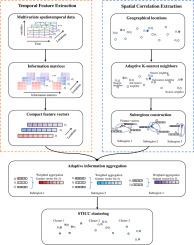基于自适应信息聚合的空间托普利兹反协方差的多变量时空聚类法
IF 6.5
2区 计算机科学
Q1 COMPUTER SCIENCE, ARTIFICIAL INTELLIGENCE
引用次数: 0
摘要
时空聚类是在公共安全、生态学、流行病学、地球科学等领域发现潜在和有用模式的重要技术。然而,许多时空聚类方法不能有效地捕捉时空数据中序列之间的复杂相关性,导致聚类结果在空间上分散。为此,我们提出了一种基于空间Toplitz逆协方差与自适应信息聚合(TIC-AIA)的多元时空聚类方法。具体而言,在时间维度上,我们扩展了高斯马尔可夫随机场,从多变量时空数据中提取时间特征。在空间维度上,提出了一种新的自适应k近邻算法,为每个位置构建不同大小的子区域。然后,采用自适应信息聚合机制,将时间特征与空间关联相结合,得到子区域的时空信息,并将其应用于空间Toeplitz逆协方差结构,对多变量时空数据进行聚类。此外,提出了一种新的变量重要性度量来识别不重要的变量,以优化聚类精度。实验结果表明,TIC-AIA在各种合成和真实多变量时空数据集上的聚类性能优于现有技术。本文章由计算机程序翻译,如有差异,请以英文原文为准。

Multivariate spatiotemporal clustering based on spatial Toplitz inverse covariance with adaptive information aggregation
Spatiotemporal clustering is an important technique for discovering potential and useful patterns in many areas including public safety, ecology, epidemiology, earth sciences, etc. However, many spatiotemporal clustering methods fail to effectively capture the complex correlations between sequences in spatiotemporal data, which leads to clustering results that are spatially scattered. Hence, we propose a multivariate spatiotemporal clustering method based on spatial Toplitz Inverse Covariance with Adaptive Information Aggregation (TIC-AIA). Specifically, in the temporal dimension, we extend Gaussian Markov Random Field to extract temporal features from multivariate spatiotemporal data. In the spatial dimension, a new adaptive K-nearest neighbor algorithm is proposed to construct subregions of different sizes for each location. Then, an adaptive information aggregation mechanism is employed to integrate temporal features and spatial correlations to obtain the spatiotemporal information of subregions, which are applied to the spatial Toeplitz inverse covariance structure for clustering multivariate spatiotemporal data. Additionally, a new variable importance metric is developed to identify unimportant variables to optimize the clustering accuracy. Experimental results show that TIC-AIA outperforms existing techniques in clustering performance across various synthetic and real-world multivariate spatiotemporal datasets.
求助全文
通过发布文献求助,成功后即可免费获取论文全文。
去求助
来源期刊

Neurocomputing
工程技术-计算机:人工智能
CiteScore
13.10
自引率
10.00%
发文量
1382
审稿时长
70 days
期刊介绍:
Neurocomputing publishes articles describing recent fundamental contributions in the field of neurocomputing. Neurocomputing theory, practice and applications are the essential topics being covered.
 求助内容:
求助内容: 应助结果提醒方式:
应助结果提醒方式:


